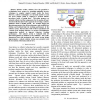Free Online Productivity Tools
i2Speak
i2Symbol
i2OCR
iTex2Img
iWeb2Print
iWeb2Shot
i2Type
iPdf2Split
iPdf2Merge
i2Bopomofo
i2Arabic
i2Style
i2Image
i2PDF
iLatex2Rtf
Sci2ools
ICRA
2010
IEEE
2010
IEEE
Design and control of motion compensation cardiac catheters
Robotic cardiac catheters have the potential to revolutionize heart surgery by extending minimally invasive techniques to complex surgical repairs inside the heart. However, catheter technologies are currently unable to track fast tissue motion, which is required to perform delicate procedures inside a beating heart. This paper proposes an actuated catheter tool that compensates for the motion of heart structures like the mitral valve apparatus by servoing a catheter guidewire inside a flexible sheath. We examine design and operation parameters that affect performance and establish that friction and backlash limit the tracking performance of the catheter system. Based on the results of these experiments and a model of the backlash behavior, we propose and implement compensation methods to improve trajectory tracking performance. The catheter system is evaluated with 3D ultrasound guidance in simulate in vivo conditions. The results demonstrate that with mechanical and control system de...
| Added | 13 Feb 2011 |
| Updated | 13 Feb 2011 |
| Type | Journal |
| Year | 2010 |
| Where | ICRA |
| Authors | Samuel B. Kesner, Robert D. Howe |
Comments (0)

